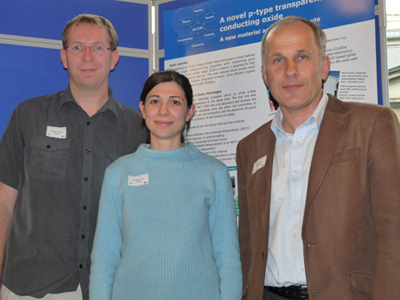CRANN nanoscience institute at TCD
Researchers at CRANN, the Science Foundation Ireland-funded nanoscience institute based at Trinity College Dublin (TCD), say they have discovered a new material that could transform the quality, lifespan and efficiency of flat-screen computers, TVs and other solar-cell and LED devices.
A patent application protecting the new material has been filed by TCD.
Prof Igor Shvets, a CRANN principal investigator, led the research team. His research was published in the international science publication Applied Physics Letters in 2011.
He said the research team was hopeful this initial research would attract commercial interest in order to explore its industrial use.
“The new material could lead to innovations such as window-integrated flat screens. It could also increase the efficiency of certain solar cells, increasing their take-up and helping to reduce carbon emissions,” said Shvets.
Speaking this afternoon, however, Shvets said that the team now needs to replicate the method of growth of this material using other materials in order to clarify what the limitations are, before they can start thinking about commercialising their research.
The two other members of the CRANN research team, along with Shvets are Dr Karsten Fleisher and final-year PhD student Elisabetta Fleischer.

Professor Igor Shvets (far right), pictured with Dr Karsten Fleischer and PhD student Elisabetta Arca at TCD. Image courtesy of the TCD Communications Office
Nanoscience and Ireland
CRANN’s executive director Dr Diarmuid O’Brien, spoke about how Ireland is paving the way for nanoscience research.
“We are working with leading companies such as Intel and HP in this sphere and helping them to improve their products using our innovative research methods. This new material could be of real significance to our industry partners,” he said.
According to the CRANN researchers, devices that the new material could be used with include solar cells, flat-screen TVs and computer monitors and LEDs, which utilise materials that can conduct electricity and at the same time are transparent.
They spoke about how these devices currently use transparent conducting oxides, describing them as a good compromise between electrical conductivity and optical transparency.
“They all have one fundamental limitation: they all conduct electricity through the movement of electrons. Such materials are referred to as n-type transparent conducting oxides. Electricity can also be conducted through as p-type materials. Modern-day electronics make use of n-type and p-type materials,” said the team.
They said lack of good quality p-type transparent conducting oxides, however, led them to develop a new material – a p-type transparent conducting oxide.
And as well as being a scientist, Shvets has practical experience in commercialising research. He launched and sold two spin-outs from TCD – Deerac Fluidics, which was acquired by Labcyte; and the biotechnology firm Cellix, which he co-founded in 2004.
In 2010, he co-founded a third TCD campus company called Miravex, which specialises in the areas of optics and image analysis for the cosmetic investigation of skin conditions. A spin-out since 2010, Miravex is now run by graduates of Shvets’ research group, as they decided to opt for the entrepreneurial route. Shvets remains a non-executive director of Miravex.
He is also a co-founder of the Spirit of Ireland energy project.
He holds a Personal Chair in applied physics, created in 2007 in recognition of his scientific and professional contribution to his discipline and to TCD. He is the inventor of more than 50 patent and patent applications in Europe and the US.